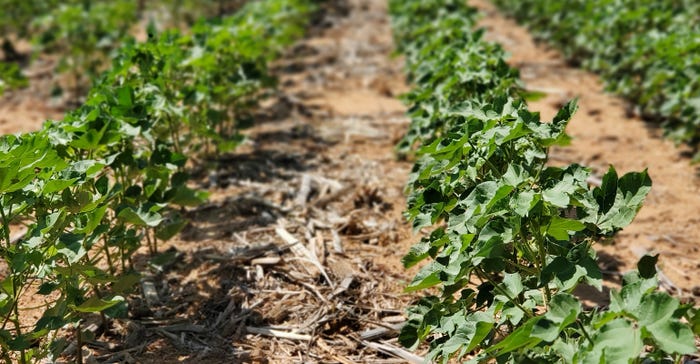
Last year Jeff Posey’s irrigated cotton produced the best yields he’d seen in 10 or 15 years, an outcome he credits to spring rains that recharged his shallow wells.
He doesn’t have that luxury so far this season.
“When we have good rains, we get good recharge to our aquifer. With good spring rain last year, we had a good season. We started in good shape for the summer. This year, we’ve had no aquifer recharge.”
Posey says wells on his Roby, Texas, farm — 3 J Posey Farms — are shallow, only about 30 to 40 feet. “That’s a blessing and a curse,” he says. “It doesn’t cost a lot to get water to the surface, but when it’s dry, they deplete fast.”
Saline water
That shallow aquifer presents another problem—water quality. “We have to manage irrigation carefully here in Fisher County,” Posey says. “The shallower the aquifer, the more salt we get in the water. The drier it gets the more salt the water has. The shallower the aquifer, saline concentration is higher.”
High salinity limits what farmers in the area can do before planting. Pre-watering is out of the question, Posey says, unless he sees a high possibility of rain.
“We have to be careful not to get too much salt on the soil surface or the seed will not sprout. We really can’t pre-water. We just don’t do it.”
Posey says about 70% of their irrigated land, which he manages with his sons Stuart and Joe, is in subsurface drip irrigation. The other 30% is under pivots.
 Jeff and Phiney Posey's 2020 cotton crop. The Poseys rotate cotton and wheat and "a little corn." (Photo by Shelley E. Huguley)
Jeff and Phiney Posey's 2020 cotton crop. The Poseys rotate cotton and wheat and "a little corn." (Photo by Shelley E. Huguley)
“If we had good water quality, we would pre-water the drip acreage,” he says. “If we could pre-water and then get a 2 tenths- to 3 tenths-inch rain, that would water it in good. We might pre-water a little if we see a rain cloud coming. If it’s dry, we have to be careful.”
Like many Southwest producers, Posey irrigates as a supplement to rainfall. “On irrigated land, the less rain we get the less yield we make.”
He says farmers depend on Mother Nature’s benevolence to provide rainfall, but he does what he can to improve his odds.
Rotation helps
“We rotate cotton with wheat and a little corn. We had one pivot in hay grazer last year. That rotation helps us get organic matter on top of the ground, which helps with the salt issue. We try to rotate a summer and a spring crop with pivots that are next to each other.”
Posey says irrigation management is a constant learning curve. “Most producers learn in the first year or two about the irrigation systems they have and then continue learning from that point forward.”
Water availability and quality have changed a lot in the last 20 years or so, he says. “Producers who were accustomed to having 5 to 6 gallons per acre for irrigation and now have only 2 to 3 find it hard to adjust.”
He says reports from the High Plains indicate farmers there do not have the water they had 20 years ago. “In areas close to us, on the Seymour aquifer, water may be a little deeper, down 60 feet or so, and the quality might not be as bad as ours.”
Improved efficiency
He says subsurface drip still has salt issues but does improves irrigation efficiency. “We are definitely more efficient with drip, and we get a little better yield, 50-to 200-pounds of cotton per acre compared to pivots.”
He improves pivot efficiency too. “We try to keep pivot nozzles as low to the ground as possible to prevent evaporation loss and to keep water off the leaves as much as possible. We keep nozzles as low as we can.”
Most years, once irrigation starts, it’s non-stop until the crop is made. “In the summer, it would take a good 2-inch rain to turn off the irrigation. Usually, by the second week of July, we turn the water on and keep it running well into September. We will run irrigation, drip and pivot, two months straight without shutting it off. In the past, irrigation has been one of our bigger expenses. It’s hard to figure just what is the biggest this year.”
All irrigation runs off electricity. “We are fortunate to have a good rural electric co-op.”
As he and his sons prepare for 2022 planting, Posey hopes for enough rain to plant in good moisture and to allow the irrigation systems to keep up with crop demand.
“We’re always praying for rain,” he says. “We always say, ‘if we could have just had one more rain.’”
About the Author(s)
You May Also Like






